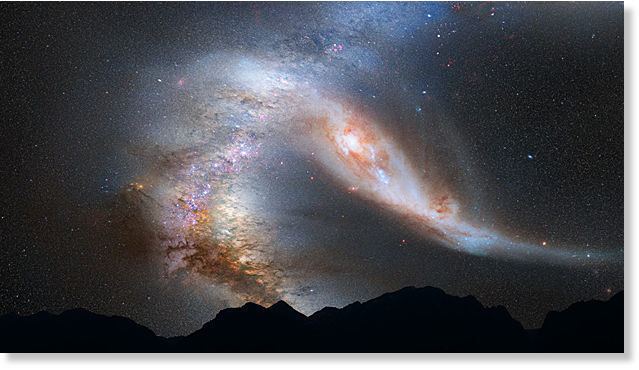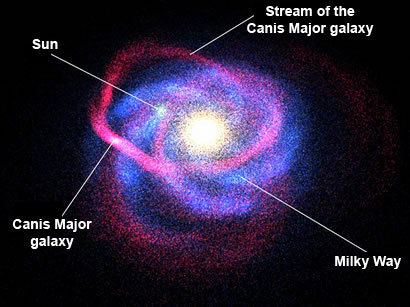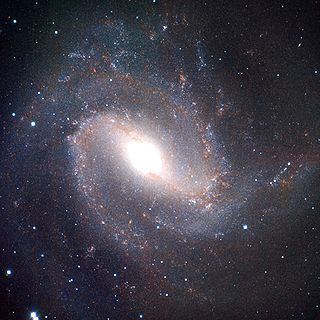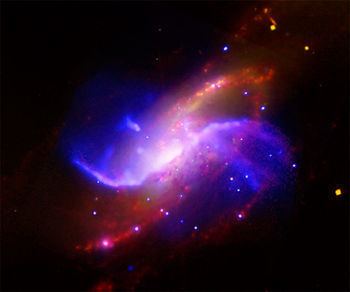Right ascension 07 12 35.0 Type Irr Distance to Earth 25,000 light years | Declination −27° 40′ 00″ Number of stars 1 billion (1×10) | |
 | ||
Apparent size (V) 12 degrees × 12 degrees Similar Sagittarius Dwarf Spheroid, Ursa Minor Dwarf, Draco Dwarf, Leo II, Leo I | ||
The Canis Major Dwarf Galaxy (CMa Dwarf) or Canis Major Overdensity (CMa Overdensity) is a disputed dwarf irregular galaxy in the Local Group, located in the same part of the sky as the constellation Canis Major.
Contents

The supposed small galaxy contains a relatively high percentage of red giants, and is thought to contain an estimated one billion stars in all.

The Canis Major Dwarf Galaxy is classified as an irregular galaxy and is now thought to be the closest neighbouring galaxy to the Earth's location in the Milky Way, being located about 25,000 light-years away from the Solar System and 42,000 light-years from the Galactic Center. It has a roughly elliptical shape and is thought to contain as many stars as the Sagittarius Dwarf Elliptical Galaxy, the previous contender for closest galaxy to our location in the Milky Way.

Discovery

The existence of a strong elliptical-shaped stellar over-density was reported in November 2003 by an international team of French, Italian, British and Australian astronomers, who claimed their study pointed to a newly discovered dwarf galaxy: the Canis Major Dwarf Galaxy. This structure is located closer to the Sun than the center of our galaxy, at approximately 7 kpc from the Sun.

The team of astronomers that discovered it were collaborating on analysis of data from the Two-Micron All Sky Survey (2MASS), a comprehensive survey of the sky in infrared light, which is not blocked by gas and dust as severely as visible light. Because of this technique, scientists were able to detect a very significant over-density of class M giant stars in a part of the sky occupied by the Canis Major Constellation, along with several other related structures composed of this Type of star, two of which form broad, faint arcs.
Characteristics

Astronomers believe that the dwarf galaxy is in the process of being pulled apart by the gravitational field of the more massive Milky Way galaxy. The main body of the galaxy is extremely degraded. Tidal disruption causes a long filament of stars to trail behind it as it orbits the Milky Way, forming a complex ringlike structure sometimes referred to as the Monoceros Ring, which wraps around our galaxy three times. The stream of stars was first discovered in the early 21st century by astronomers conducting the Sloan Digital Sky Survey. It was in the course of investigating this ring of stars, and a closely spaced group of globular clusters similar to those associated with the Sagittarius Dwarf Elliptical Galaxy, that the Canis Major Dwarf Galaxy was discovered.
Globular clusters thought to be associated with the Canis Major Dwarf galaxy include NGC 1851, NGC 1904, NGC 2298 and NGC 2808, all of which are likely to be remnants of the galaxy's globular cluster system before its accretion, or swallowing, into the Milky Way. NGC 1261 is another nearby cluster, but its velocity is different enough from that of the others to make its relation to the system unclear. The Canis Major Dwarf Galaxy may also have associated open clusters, including Dolidze 25 and H18, and possibly AM 2. It is thought that the open clusters may have formed due to the dwarf galaxy's gravity perturbing material in the galactic disk and stimulating star formation.
The discovery of the Canis Major Dwarf Galaxy and subsequent analysis of the stars associated with it has provided some support for the current theory that galaxies may grow in size by swallowing their smaller neighbors. Martin et al. believe that the preponderance of evidence points to the accretion of a small satellite galaxy of the Milky Way which was orbiting roughly in the plane of the galactic disk.
Dispute
Several studies cast doubts on the true nature of this overdensity. Some research suggests that the trail of stars is actually part of the warped galactic thin disk and thick disc population and not a result of the collision of the Milky Way with a dwarf spheroidal galaxy. Investigation of the area in 2009 yielded only ten RR Lyrae variable stars which is consistent with the Milky Way's halo and thick disk populations rather than a separate dwarf spheroidal galaxy.
